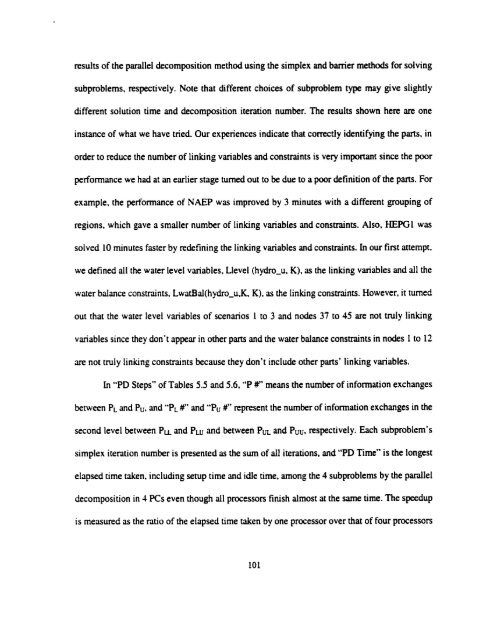X - UWSpace - University of Waterloo
X - UWSpace - University of Waterloo
X - UWSpace - University of Waterloo
Create successful ePaper yourself
Turn your PDF publications into a flip-book with our unique Google optimized e-Paper software.
esults <strong>of</strong> the parallel decomposition method using the simpiex and banier methods for solving<br />
subproblems, respectively. Note that diffennt choices <strong>of</strong> subproblem type may give slightly<br />
different solution time and decomposition iteration number. The results shown here are one<br />
instance <strong>of</strong> what we have tried. Our experiences indicate that comctly identifying the parts, in<br />
order to reduce the number <strong>of</strong> linking variables and constraints is vely important since the poor<br />
performance we had at an earlier stage tumed out to be due to a poor definition <strong>of</strong> the parts. For<br />
example. the performance <strong>of</strong> NAEP was improved by 3 minutes with a different grouping <strong>of</strong><br />
regions, which gave a smaller number <strong>of</strong> linking variables and constraints. Also. HEPGl was<br />
solved 10 minutes faster by redefining the linking variables and consuoints. In our first attempt,<br />
we defined al1 the water level variables. Uevel (hy-u, K), as the linking variables and dl the<br />
water balance consaaints. LwûtBal(hydro-u.K. K), as the linking consaints However, it tumed<br />
out that the water level variables <strong>of</strong> scenarios 1 to 3 and nodes 37 to 45 are not tmly linking<br />
variables since they don't appear in other parts and the water balance constnints in nodes 1 to 12<br />
are not trul y linking constraints because they don't include other parts' linking variables.<br />
in "PD Steps" <strong>of</strong> Tables 5.5 and 5.6, "P W* means the number <strong>of</strong> information exchanges<br />
between PL and Pu, and "Pr W' and "Pu #" represent the number <strong>of</strong> information exchanges in the<br />
second level between Pu and PLU and between PUL and Pvu, respectively. Each subproblem's<br />
simplex itention number is presented as the sum <strong>of</strong> al1 itentions. and "PD Time" is the longest<br />
elqsed time taken. including setup time and idle time, arnong the 4 subproblerns by the parailel<br />
decomposition in 4 PCs even though al1 processors finish almost at the same time. The speedup<br />
is mesured as the ratio <strong>of</strong> the elapsed time taken by one processor over that <strong>of</strong> four processors
















